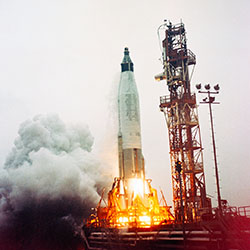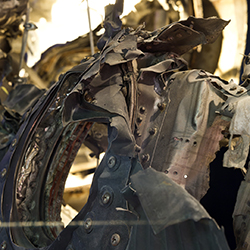No one was hurt when the first major launch of the Mercury program, the Mercury-Atlas 1, ended in disaster on July 29, 1960.
An Atlas rocket attached to an uncrewed Mercury spacecraft flew for almost a minute before an explosion knocked them both out of the sky, sending them plummeting over five miles down into the ocean. The Mercury Seven astronauts were on hand to witness the launch.
As Atlas fragments rained from the clouds , astronaut Alan Shepard calmly turned to red-faced engineers, “You’re going to fix that, aren’t you.”

The rocket was never recovered, but the remains of the capsule are among the captivating artifacts in our Hall of Space Museum. (See image above.)
An Example of Persistence.

The oddly twisted metal of the recovered Mercury capsule walls seems like a fascinating sculpture. This epic fail could’ve doomed the fledgling US space program, but instead it spurred design improvements that eventually led to Mercury spacecraft carrying the first Americans into space.
And in fact, the basic model for space travel that Mercury-Atlas 1 used is still used today: one rocket and one capsule launching while attached, then separating in the air.
“Only those who dare to fail greatly can ever achieve greatly.” – Robert F. Kennedy
Worst Work Meetings Ever?
Before they could move forward with new Mercury launches, NASA had to figure out what went wrong with Mercury-Atlas 1, or MA-1, as it’s known for short.
The pressure on this investigation to come up with a clear answer was intense. The future funding of the US space program depended on whether NASA could demonstrate that it knew what caused the explosion and that it knew how to prevent similar problems in the future.
This ended up being pretty tricky. No one actually saw what happened because the explosion took place high above banks of dark rain clouds that obscured the spacecraft from view.

Data from remote sensors was inconclusive.
For weeks after the explosion, there were meetings of those involved in the Mercury-Atlas 1 engineering and mission planning.
Meetings in Washington, D.C. Meetings in Langley, Virginia. Meetings at Cape Canaveral. Meetings in San Diego, where the Atlas was made.
Nothing definitive was found after a month.
More meetings.
Nine metallurgical engineers took a fine-toothed theoretical comb to what NASA saw as the most likely point of failure (brace for engineering language), “metal fatigue of the lox-vent valve elbow.” *
But nope. According to those nine experts, that wasn’t it, either.
With all those meetings leading to zero final conclusions, a new “seven-man joint capsule-booster interface inspection” * committee was assembled in September.
Twenty-three members of a separate panel “reexamined each other’s previous answers to the enigma of MA-1.” *
NASA’s online history site, in a true understatement, describes the investigation at that point as “unsatisfying.” *
Eureka!
Ultimately, consensus emerged based partly on observations of the recovered remnants.
The cause of the explosion? A collar connecting the capsule to the booster wasn’t strong enough to withstand the pressure and friction of holding the two massive machines together during the flight.
The collar crumpled, causing the booster and capsule to be torn apart.
This feature was strengthened for future missions, and in February 1961, MA-2 flew a picture-perfect suborbital trip.
Read more about Mercury-Atlas 1 in the Cosmosphere’s Hall of Space Museum.
*Thanks to NASA’s history site for these quotes and for background information for this post.



